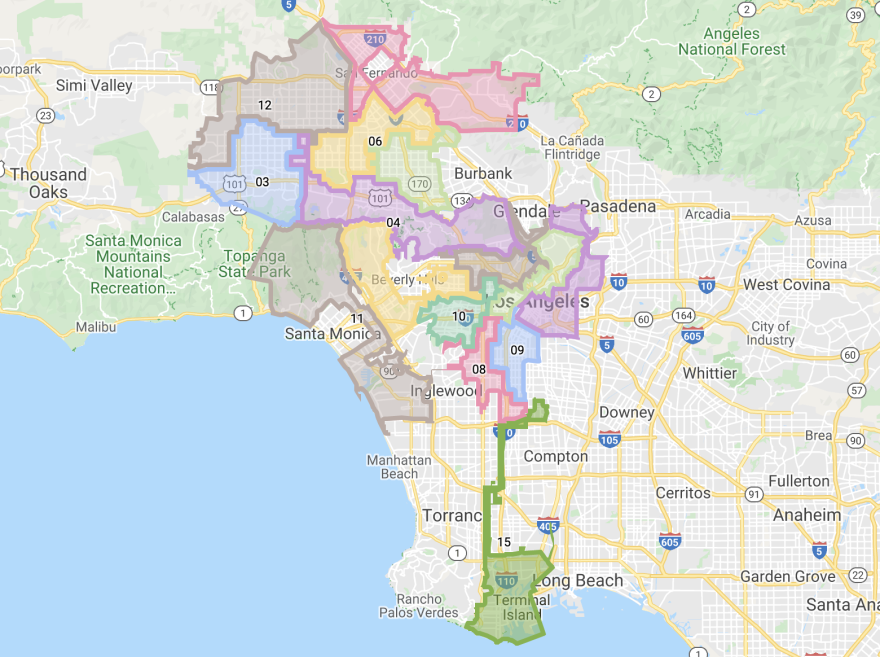Truth matters. Community matters. Your support makes both possible. LAist is one of the few places where news remains independent and free from political and corporate influence. Stand up for truth and for LAist. Make your year-end tax-deductible gift now.
Check Out The Proposed New Map Of LA's City Council Districts

The incredibly important — and the incredibly tough-to-follow — process of redrawing political maps continues in the city of Los Angeles.
Now, you can take a look at the possible future of L.A.’s city council districts in a new, detailed map shared Monday by the city clerk. (For comparison, here are the current districts.)
The city council’s newly-formed ad hoc redistricting committee advanced this “hybrid” map when it met for the first time Friday afternoon:
The city council will consider the map during Tuesday's regular meeting then the first of two state-mandated public hearings will kick off at noon on Wednesday.
The ad hoc committee tackled a slew of motions brought by council members who wanted changes to the redistricting commission’s map, dubbed “K2.5 Final,” submitted last month.
Redistricting is informed by results of the 2020 Census. Every 10 years, political boundaries have to be reshaped to make populations roughly equal across all districts. For the L.A. City Council, that pens out to about 260,000 people per district. The Voting Rights Act also governs this process, requiring redistricting panels to protect the power of minority voters to choose their own representatives.
The city’s redistricting commission, made up of appointees chosen by elected officials in L.A., including the mayor, city attorney and city council, drafted its proposed map after months of public hearings and wrangling between stakeholders.
All along, the commission had acknowledged that the council itself would have the final say. Almost as soon as the proposed map hit the Internet, Council President Nury Martinez joined a chorus of critics unhappy with the draft boundaries.
The “K2.5 Final” map carved out notable parts of Martinez’s district, such as the Sepulveda Basin Recreation Area and dramatically retooled council districts two and four, represented by Paul Krekorian and Nithya Raman, who would be thrust into districts with new constituents.
As chair of the committee, Martinez on Friday instead backed a “hybrid” map that combined recommendations from the redistricting commission for districts in the L.A. basin with a map drafted by a group of Latino labor leaders for the boundaries of San Fernando Valley districts. (Details can be found in a Chief Legislative Analyst report submitted Nov. 5.)
Councilmember Raman was the lone opposition vote to the hybrid map, which passed 6-1. She argued her 4th district would still be drastically overhauled, before unsuccessfully proposing a motion to consider another alternative map.
“[The 4th] district continues to be the most impacted of any of the districts by the changes proposed,” Raman said at the ad hoc committee meeting Friday, pointing out that CD 4 would lose more than 40% of its current constituents, far and away more than the changes faced by other districts.
Raman’s district would now stretch from Los Feliz to Sherman Oaks and the Skirball Center, even reaching an arm up to include parts of Reseda. It would be the only “valley cross-over” district bridging parts of the San Fernando Valley and the Los Angeles basin.
In her opening statement during Friday’s meeting, Martinez also decried what she says is an undercount of poor and minority communities in Los Angeles, because of the Trump Administration’s failed effort to include a citizenship question on the decennial survey.
“This was the Trump census,” Martinez said. “Los Angeles numbers are simply not accurate. Look around you. We did not get whiter and we did not get wealthier.”
She added that big population losses in districts one and thirteen illustrated this: “If you go down Figueroa in Highland Park or Sunset in Echo Park, there is a clear boom going on in these districts, yet the census would have you believe that there is a loss of population. And that is an undercount.”
John Wickham with the Chief Legislative Analyst’s office cited research by UCLA indicating a likely undercount in Los Angeles County, considered one of the hardest areas to achieve accurate response rates. Neighborhoods with high numbers of immigrants, majority Latino or Asian populations, lots of renters and low incomes were most likely to be undercounted, according to UCLA’s Center for Neighborhood Knowledge.
“We probably won’t know the extent of the undercount for several years,” Wickham said.
The city council is targeting a final vote on the new maps by early December. They must be approved by the end of the year, per the city charter.







